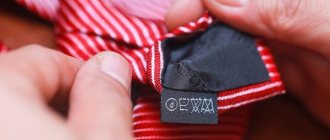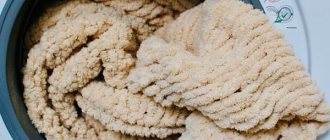Recently, winter jackets with artificial or natural insulation – parkas – have come into fashion. They can often be seen in cold weather in adults and the younger generation. To make them look good, you need to take care of them, taking into account the nuances. Before washing your parka, you should read the washing instructions. Considering the material of manufacture, the products can be washed in a machine or by hand.
Proper preparation for washing parkas in a washing machine
If you wash the product in a machine, you must perform the following preparatory procedures:
- Empty your pockets from various small items.
- Unfasten the parts that are attached to zippers, buttons and other fasteners. These usually include a collar, some pockets, a hood, and a warm lining.
- Close all remaining zippers and fasten buttons. Otherwise, they may damage the fabric during washing.
- Turn the product inside out.
- If the housewife has a thin bag for washing woolen and delicate fabrics, put the parka in it. This will serve as another guarantee that it will not deteriorate due to mechanical stress.
- Place the jacket in the washing drum. Do not put together with other clothes to prevent staining from them.
Important! The temperature should not exceed 40 degrees. Otherwise, the fabric may become deformed.
How to iron silk
2. Leave ironing of delicate fabrics until last.
The iron is designed in such a way that it takes longer to cool down than to heat up. In other words, the iron heats up very quickly.
We suggest you familiarize yourself with How you can clean grease from your hood
Therefore, start ironing with materials that require the lowest temperature, such as polyester and silk. Then move on to cotton and linen. If you neglect this simple rule, you risk melting the fabric and ruining your clothes.
3. Iron at high temperatures
If the garment is made from multiple materials, select the setting for thinner or more delicate fabrics. This will help you preserve your clothes.
Rules for washing parkas made of cotton, polyamide and membrane fabric
How to wash a parka correctly is dictated by the material of the fabric. When washing cotton or polyamide items, you must set the mode indicator to delicate treatment. Set the temperature to 40 degrees, turn off the drying. When cleaning a white parka, you can add bleach.
Before washing outerwear made of membrane fabric, the temperature in the machine should be set to 30 degrees. As a detergent, buy a special preparation for cleaning membrane fabrics. You need to set the mode indicator to delicate washing, turn off spinning and drying. It is allowed to wash the membrane material in a basin with your hands in cool water.
Attention! Fabric softeners (rinse aids) are not used. They negatively affect the ability of the parka to “breathe”.
Machine washable
As a rule, cotton or polyamide, or a combination of both, is used to sew a parka. In rare cases, membrane fabric is used. Accordingly, the washing method will differ depending on the material.
- Jackets made from membrane fabric should be washed at 30 degrees. Ordinary powder can simply ruin the fabric and deprive it of its unique qualities, so it is better to buy detergents for membrane products.
- It is better to wash this parka by hand or on a delicate cycle in an automatic machine.
- A parka made of membrane fabric should not be wrung out or twisted.
- They can be safely washed in a washing machine at 40 degrees.
- The drying mode must be turned off.
- When washing a white jacket, you can use oxygen bleaches.
We suggest you familiarize yourself with How to iron a polo - Clean in the house
All other points depend on what kind of insulation is in the jacket.
This is the simplest option; such jackets can easily be washed in an automatic machine:
- Place the jacket in the washing machine drum. If there is a special bag for washing, it is better to use it. It will protect your jacket from deformation.
- Set the wash cycle to synthetic or delicate.
- It is best to turn off drying and spinning.
- When washing, you can use regular powders.
- Wring out the washed item lightly with your hands and hang it to dry.
- Turn the jacket inside out, put a few tennis balls inside, put it in a special laundry bag and put it in the drum.
- For washing, use a special liquid detergent for washing down jackets. As a last resort, you can use liquid gel for washing woolen items. Pour this product directly into the washing machine drum.
- Set the wash cycle to delicate and temperature 40 degrees.
- The spin must be set at minimum speed.
- It is best to turn off the dryer completely.
- If possible, set the extra rinse function.
It's best if the fur lining can be detached. In this case, the jacket is washed as usual, and the fur can be dry cleaned. But if this is not possible, then you can try to clean the jacket with fur yourself.
- In the washing machine in cold water, setting the delicate cycle. No spinning or drying. You need to wash it with special fur cleaning products.
- Manually, dissolving detergent in water, using a clothes brush. You need to clean the fur in the direction of the pile and do not press too hard. Do not twist the fur, just squeeze it slightly and let it drain. You can wrap the fur in a terry towel. It will absorb excess water.
How to wash a parka with padding polyester
There are rules on how to wash a winter parka using padding polyester. These jackets are machine washable. The washing method should be set to “Delicate” or “Synthetic”. The product cannot be wrung out or dried in a machine. You can use regular washing machine powder for cleaning, for colored wardrobe items. After completing the procedure, the jacket should be wrung out a little by hand without twisting and hung on hangers over a large basin to dry.
What should you pay attention to when steaming?
Before steaming, you should check the iron itself, since along with the steam it can release particles of scale and scale. To clean, fill the reservoir with water and heat the iron at maximum power. Then you need to place the device horizontally over the sink and press the self-cleaning button. A jet of steam and water will wash away all mineral deposits.
If there is no self-cleaning button, you can remove scale using water with the addition of table vinegar or citric acid. The solution should be poured into the tank, then turn on the electrical appliance and leave it in this state for about 10 minutes. After this, you need to place a container under the iron to collect moisture and, holding the iron horizontally, press and hold the steam release button until contaminated moisture stops flowing out of the holes on the soleplate.
How to wash a parka with fur
Before you wash a parka with a fur lining at home, you need to familiarize yourself with the nuances of caring for fur clothing. Real fur is difficult to clean at home. If you wash it in water, it will disfigure the product. If there is a liner made from animal skin, it should be removed from the jacket and taken to dry cleaning. If this is not possible, you can clean the fur using folk remedies, without water.
Most often, natural linings are made from sheepskin. Here are some popular methods on how to clean it:
- Grease stains can be cleaned with dishwashing detergent. They should be applied to the stain, and after a few minutes, rinse with water.
- Starch, soda or semolina are used as a bleaching agent. The product should be applied to the fur, lightly rubbed, and then the dirt should be removed with a vacuum cleaner.
- A good effect is achieved by mixing the yolk with Vaseline. The fur needs to be treated with the mixture. Once dry, clean it with a clothes brush.
- Restoring the original color of the lining is achieved by using crushed walnuts. It must be placed in gauze and the lining lightly rubbed.
- A stain on the backing can be removed with a mixture of water and ammonia in a ratio of 1:2. Apply the solution to the stain and then wash it off with a damp sponge.
- Potato skins must be washed and chopped in a blender. Apply the mixture to the fur. It will absorb dust and dirt. After a quarter of an hour, clean off the product with a clothes brush or vacuum cleaner.
Faux fur is easy to clean at home. There are 2 options for cleaning fur. The first is to machine wash the fur lining. You need to set the mode indicator to “Delicates”. Turn off squeezing and machine drying. Use only liquid fur cleaning products.
We recommend:
Is it possible to wash a camel wool blanket?
The second option is to wash it in a basin by hand. The basin should be filled with slightly warm water, and the detergent should be stirred in it. Place the liner there and clean it with a hair brush, brushing it in the direction of the fibers. You need to squeeze the product lightly and very carefully. Some housewives prefer to wrap the fur lining in a towel to absorb excess moisture. Then it must be hung over a large basin on a hanger.
Information: to give the fur a new look, after finishing the process, comb it with a fine comb.
Features of polyester
Polyester is obtained as a result of a chemical reaction of monomers made from petroleum distillation products.
The material retains heat and does not allow moisture to pass through, which is why it is widely used in the production of winter and demi-season clothing. To the touch, polyester can resemble various natural fabrics: cotton, wool, silk. What exact effect will be achieved during the production of the material depends on the production method and the presence of additional fibers. On sale, polyester can have different names: lavsan, tesil, tetheron, trevira, dacron and others. Main characteristics of the material:
- density (g/cm3) – 1.38-1.4;
- moisture absorption – 0.3%;
- percentage of elongation – 12-50;
- solubility in acetone, toluene, ethyl acetate;
- resistance to solvents and acids;
- resistance to pilling;
- immunity to bacteria and other microorganisms.
Polyester fibers are sensitive to high temperatures, so it is important to take care of things made from polyester with care. However, this quality allows manufacturers to deform products, creating a pleating effect, a “reaper”, and make complex clips that will remain for the entire life of the garment.
Each material from which windbreakers are made has certain nuances and limitations when ironing. Let's consider each of the cases in more detail.
Raincoat
Raincoat fabric is ideal for sewing windbreakers. It is very practical and comfortable to wear. However, it wrinkles easily and may require ironing.
Before you begin the ironing process, you should read the label, which is usually sewn into the back of the collar or side seam. It indicates how you can iron this item.
Manufacturers often warn that ironing is not allowed, but steaming can be used.
Even if the manufacturer allows regular ironing, it is better to use steaming for raincoat fabric using an iron with the appropriate function or a steam generator.
This happens according to the following scheme:
- Water is poured into the steam generator or iron.
- Heat the device to the minimum temperature.
- Hang the windbreaker on a hanger.
- Steam, holding the steam generator at a distance of 10-15 cm from the fabric.
- Leave the item on a hanger until it cools completely.
You need to choose an ironing method taking into account the characteristics of both the main fabric and the lining fabric. The lining may be even more sensitive to high temperatures than the outer fabric.
Polyester
Polyester items hardly wrinkle. But if the windbreaker has been folded for a long time, deep, unsightly creases may form on it.
In the case of polyester, it is also important to take into account the information from the manufacturer on the tag. Ironing is usually allowed, but only with minimal heating to a temperature of 110 degrees.
It is carried out according to the following plan:
- the windbreaker is turned inside out;
- The area for ironing is covered with damp gauze;
- Ironing should be done with quick movements, without holding the iron in one place.
If after such delicate treatment the folds remain, you can try to smooth the fabric with water.
To do this, the jacket is moistened with warm water from a spray bottle and left on hangers until completely dry.
Most manufacturers sew a small piece of fabric from which the product itself consists to the reverse side of their products.
Many people believe that this flap is intended to be used to make a patch if necessary.
In fact, it is included specifically for ironing testing. You should check the reaction of the fabric to the iron on this piece, and not on the product itself.
Nylon
This is a universal elastic material. It does not tolerate high temperatures and can become deformed when wet. The information on the label is also important here.
Typically, such items are allowed to be ironed at a minimum temperature or steamed, also at the lowest heat.
You need to iron through wet gauze with quick movements. When steaming, keep the iron or steam generator at a distance of 15 cm and also do not linger in one place.
After finishing the ironing process, leave the windbreaker hanging on hangers for 2-3 hours. After this, you can wear it or hang it in the closet.
This material has become very popular recently. Comfortable, beautiful and comfortable to wear things are sewn from it. You cannot iron them, but you can steam them in a gentle mode.
Before steaming, the item should be hung on hangers in a place where it will not be exposed to direct sunlight or strong drafts. After this, heat the steamer or iron with vertical steam mode to a temperature of 100 degrees.
Treat all crushed areas, holding the device at a maximum distance, and avoiding strong heating of individual areas of the fabric. After steaming, the windbreaker should hang slightly straightened out.
Bologna
The ability to iron items made from bologna depends on the ratio of fibers and density of the material.
Therefore, all stages of caring for a Bolognese windbreaker must be performed in accordance with the recommendations indicated on the tag.
Thick fabric can be ironed without using wet gauze. However, first it is better to try ironing a small section of the windbreaker in an inconspicuous place.
You can iron the item only if the fabric in the experimental area has not shrunk or become rough. Thin bologna can only be steamed in a gentle mode.
Cotton
Light outerwear can be made of cotton. Such things wrinkle even during wear. You can iron them in this way:
- The windbreaker is laid out on the ironing board.
- Moisten generously with a spray bottle.
- Heat the iron to a temperature of 200 degrees.
- Iron the item, gradually moving from one area to another.
- Large and deep creases are additionally moistened and ironed with increased care.
Proper drying of a winter parka
Drying is the final stage. As a rule, parkas are made from wrinkle-resistant fabrics and do not require ironing. Drying is carried out equally for all types of matter:
- After washing, you should not immediately remove the jacket from the machine drum; you must allow time for the water to drain.
- Then you should remove the product and turn it outside, except for the sleeves.
- Hang the parka on hangers over a bathtub or large basin.
- Remove excess water by running your hands over the fabric from top to bottom several times with some pressure.
- Turn out the sleeves.
- Leave the product hanging over the bathtub until the water stops dripping.
- Smooth and level the material with your hands.
- Place the hanger with the jacket on the balcony in the shade until the material dries completely.
Important! The parka should not be dried on a radiator or near heat sources. It can become deformed at high temperatures.
A winter jacket can be washed in a machine, if you take into account the material it is made of and know the rules for cleaning a particular fabric. Lining made from animal skins should be dry cleaned, and faux fur can be washed in a washing machine or by hand. The temperature of the water in the drum or basin when cleaning the parka should not be higher than 40 degrees. You should select the “Delicate” mode in the machine.
Steaming a jacket at home
Considering certain difficulties with ironing outerwear, it will be much easier to learn how to store it correctly. This will subsequently either completely eliminate the hassle of ironing things, or reduce them to a minimum. So, regardless of the period, the jacket should be stored only on wide wooden hangers. A thin metal hanger model will not work in this case. For long-term storage, all zippers and buttons must be fastened, and rolled up towels must be placed in the sleeves.
We invite you to familiarize yourself with Plumbing tow (linen) - how to wind tow on a thread? (video)
However, you should not stuff the sleeves too tightly, otherwise the leather may stretch and the jacket will be damaged. You just need to give them barely noticeable shapes, which will be quite enough so that at the beginning of the wearing season you don’t have to worry about smoothing them out. Then the product must be placed in a separate case, making sure that it is dry beforehand. Only clean and dried items can be stored, otherwise the item will acquire a musty smell and will require washing or dry cleaning.
Thus, with a competent approach and the right choice of ironing method, anyone can bring the jacket into proper shape. The main thing is to strictly follow the rules of ironing and steaming. You should not neglect the storage conditions of outerwear.
You will learn how to properly iron a leather jacket with an iron from the video below.
Sometimes, after washing or transportation, bolognese and polyester jackets need additional ironing. If placing it on a hanger does not solve the problem, an iron will help. It can be used to smooth dry and wet items. In the latter case, this will allow the clothes to dry if there is no time to wait.
It is recommended to iron polyester with a damp cloth
Ironing should be done very carefully, at minimum temperature. Do not allow direct contact between the iron and the jacket fabric. Ironing should be done through a cotton diaper or paper. You can also iron a garment from the inside out, but only using cushioning fabric between the iron and the clothing. The lining material is quite thin and can be damaged during direct contact with a household appliance.
The step-by-step algorithm for working with outerwear and dresses looks like this:
- Before the procedure, you should carefully study the label: the manufacturer could have left information on what temperature conditions the item can be ironed at;
- for testing, it is better to use a prototype fabric that manufacturers provide when purchasing clothes;
- turn the product inside out and set the iron to “silk”;
- You should start ironing from the lining, on which you need to place a moistened cotton cloth or gauze;
- if the jacket is made of padding polyester (thick), and deep bruises and folds are noted, it is permissible to iron the garment from the front side, using damp gauze as a spacer between the item and the iron;
- hang the product on hangers, but do not put it in the closet for several hours.
A steam generator or an iron with a vertical steam option will help you iron your jacket contactlessly, from a distance of 1-3 cm. Steam treatment will also help rid the item of stains and eliminate unpleasant odors. This simple and tissue-friendly procedure includes several steps:
- clothes are placed on hangers;
- select a mode for delicate fabrics on a household appliance (steam generator, iron);
- holding the steamer at a distance of 1-3 cm, begin the procedure, moving from top to bottom;
- First, the back is steamed, then the shoulder area and sleeves, and lastly the front and collar area.
If the “steam treatment” option is not available, you can use a trick. The jacket should be placed on hangers, zippers and buttons should be fastened. Next, wet your hands and smooth the fabric well with your palms. In the bathroom, turn on very hot water and, with the doors closed, wait until the atmosphere in it becomes like a sauna.
If stored correctly, you won’t have to think about how to iron polyester. Each time after wearing, items should be placed on a hanger with suitable hangers. For long-term storage, they should be pre-washed (or dry-cleaned). Clean items should be zipped up and covered with jacket covers.











